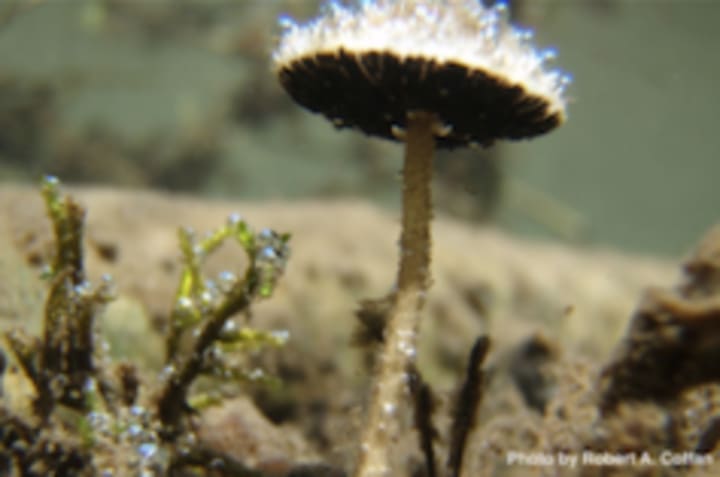Chapter 1 of Junction
The first chapter of a book I wrote that I am waiting to hear back about from US copyright office.

Mushrooms can grow under water and survive in space. If there was a species that could transverse neighbouring planets in the events of large impact events (such as the creation of the moon as is speculated) then mushrooms could certainly spread life in such a situation. Two such mushrooms noted to be able to survive space were tested by blasting them with unreasonably high doses of radiation. The Fungi “…Aspergillus and Penicillium… survived being blasted with 1’000 gray of X-ray radiation, 500 gray of heavy ions and large doses of UV radiation..” (Marta Cortesão -US National Library of Medicine National Institutes of Health).

 The mushroom that can grow underwater is called Psathyrella aquatica and is unique to Southern Oregon. Robert Coffan made the discovery in 2005 while visiting a river with his family. Found in two locations on the upper Rogue River, it is one of the most unique mushrooms in the world. Mushrooms seemingly can grow on anything, almost anywhere. The only place they do not seem to be around are both the South and North poles as well as the ocean. Although jellyfish do look a lot like mushrooms don’t they?


Coral mushrooms are related to jellyfish. They are both in the family Fungiidae of the phylum Cnidaria. Mushrooms are closer to animals than they are to plants and separated sometime after 1.1 Billion years ago. Prototaxites is an ancient giant mushroom/fungi that lived about 430 to 360 million years ago. They could grow to lengths of 3 feet wide and 26 ft high and towered over any other land based life form at the time. The mycelium of mushrooms (its “roots”) have been thought of as “the internet of the forrest” as they connect different plants and fungi together to share moisture, nutrients, and perhaps even information somehow.


If you are not familiar with the immortal jellyfish Turritopsis Dohnrii I suggest you google that cute lil fella. They are the only species that’s been called “biologically immortal” because they can revert to an earlier stage of their life cycle and indefinitely put off old age. Water Bears survive in space too, but there are more interesting things than that. Venus, Earth and Mars could have all been habitable at the same time in history at some point.

According to N.A.S.A climate models (Michael Cabbage, Leslie McCarthy - NASA) it is possible that Venus was habitable for almost 2 billion years of its life. It has been suggested that as early as 700 million years ago Venus became the hostile wasteland that it is today. Venus was habitable during the same time as Earth and Mars for at least 1 billion years: possibly more. This information is far more shocking than it might seem. Venuses climate today is described as a run-away greenhouse effect and so climatologist study it. An aging hotter Sun however could have moved the “goldylox zone” further back in space. This Goldylox Zone is known as the temperature at which water is in liquid form on the surface of the planet. In 2017 Earths average temperature was 14 degrees Celsius.
Recently (September 2020) phosphine gases were discovered in Venuses atmosphere. It is known that this gas can only be created either artificially in a lab or my micro organisms. Carl Sagan back in 1967 predicted life in the clouds of Venus. However it could still mean that there still are chemical reactions we are unaware of and this is a chance for us to study it. Either outcome is a good one for us. Carl Sagan first proposed in 1961 that Venus could be terraformed with some fictional or futuristic technologies. It is now known that Venus could have had habitable conditions long enough to develop complex life. The possibility of intelligent life having ever evolved on our neighbouring planet is there. It is currently about 471 degrees Celsius (880 degrees Fahrenheit) on the surface of Venus right about now; so any trace of life there is thoroughly obliterated.
Life on Earth started some 3.5 billion years ago in single-celled organisms. Mars could have been habitable 4.48 billion years ago (No Name - Western University) after a significant number of giant “life in-hibiting” meteorites had ceased striking the planet. Mars may have had life on it 1.3 billion years ago. A meteorite named Yamato 000593 from Mars had evidence of water and possible biotic activity. N.A.S.A rovers discovered that it is possible that Mars had conditions suited for life once based on rock samples (NASA Content Administrator - NASA). Sulfur, nitrogen, hydrogen, oxygen, phosphorus and carbon were found but they seem to lack a definitive date for this scenario. Venus stopped being habitable some 700 million years ago. The dates for Venus, Earth and Mars sharing a time in history when life could have existed on all these at the same time is not impossible. There is even evidence to suggest Earths moon was also habitable roughly 4 billion years ago and could have had two distinct periods of habitable conditions for live to survive on it (Matt Williams - Universe Today).
What possible early life survived on comets going between these planets? Could that be part of what made the life we see today so complex? If that’s true what would that mean for life that evolves in more solitude; with no neighbouring planets that have life bearing potential? Could meteors and comets carrying life from the neighbouring planets have influenced the Cambrian explosion (which occurred roughly 485 - 541 million years ago)?
What would it mean if mushrooms acted like seeds of the galaxy? They are capable of storing themselves in water molecules and survive in a multitude of inhospitable environments while capable of terraforming the terrain. Like the seeds of plants, meteors have long been suspect been planting life throughout the galaxy. The exact origins of life among all the random meteors all out in space could hardly ever be determined.
It’s kind of scary when you consider just how advanced they might be. Let me reiterate a few things at the end here. Oldest fossil evidence is that Mycelium had its form 2.4 billion years ago (lava dust in 2.4 billion years ago they found fungal mycelium called The Ongeluk discovery). The mushroom fruiting body potentially had its form 500 million to 1.2 billion years ago (Gondwangaricites magnificus gen. et sp.). They have varieties that can live under water and survive space. Turritopsis Dohnrii (the immortal jellyfish) is directly related to mushrooms in the family Fungiidae: a classification of animal of the phylum Cnidaria which includes both jellyfish and mushrooms in its classification.
Sources and images cited:
Carol Hotton; April 24 2007. Mystery prehistoric fossil verified as giant fungus. New Scientist; accessed February 10 2021: https://www.newscientist.com/article/dn11701-mystery-prehistoric-fossil-verified-as-giant-fungus/
Matt Williams. Was There a Time When the Moon was Habitable? Universe Today; July 26 2018: https://www.universetoday.com/139676/was-there-a-time-when-the-moon-was-habitable/#:~:text=According%20to%20a%20new%20study,3.5%20billion%20years%20ago).
Marta Cortesão; Aram de Haas; Rebecca Unterbusch; Akira Fujimori; Tabea Schütze; Vera Meyer; Ralf Moeller. Aspergillus niger Spores Are Highly Resistant to Space Radiation. US National Library of Medicine National Institutes of Health; April 3 2020: https://www.ncbi.nlm.nih.gov/pmc/articles/PMC7146846/
Michael Cabbage; Leslie McCarthy. NASA Climate Modeling Suggests Venus May Have Been Habitable. NASA; August 11 2016: https://www.nasa.gov/feature/goddard/2016/nasa-climate-modeling-suggests-venus-may-have-been-habitable
NASA Content Administrator. NASA Rover Finds Conditions Once Suited for Ancient Life on Mars. NASA; March 12 2013: https://www.nasa.gov/mission_pages/msl/news/msl20130312.html
No Name; No Date. Playing With Fire Underwater: Fire Coral Demystified; accessed February 10 2021: https://www.leisurepro.com/blog/explore-the-blue/playing-with-fire-underwater-fire-coral-demystified/
No Name; No Date. Cauliflower-size Coral Mushroom (genus Ramaria) growing in the Oregon woods - maybe Ramaria magnipes; accessed February 10 2021: https://www.flickr.com/photos/treebeard/8629043841/
No Name. Life on Mars was possible after last great meteorite impact nearly 4.5 billion years ago. Western University; June 24 2019: https://mediarelations.uwo.ca/2019/06/24/life-on-mars/
No Name; November 2020. Carl Sagan predicted life on Venus in 1967. We may be close to proving him right; accessed February 10 2021: https://sea.mashable.com/science/12427/carl-sagan-predicted-life-on-venus-in-1967-we-may-be-close-to-proving-him-right
No Name; February 25 2016. A Fungi Lichened To a Tree. All Is Leaf; accessed February 10 2021: https://www.allisleaf.com/2016/02/25/a-fungi-lichened-to-a-tree/
Robert A. Coffan; 2010. Mushrooms Underwater. Fishbio; accessed February 10 2021: https://fishbio.com/field-notes/wildlife-ecology/mushrooms-underwater
Steven Kovacs; 2011. Institute of Marine and Atmospheric Research; accessed February 10 2021: https://wapiti3.tumblr.com/post/135851339723/mushroom-jellyfish-was-photographed-by-steven
Yiming Chen; August 2 2016. The Strange Life of the Immortal Jellyfish; accessed February 10 2021: https://www.abc.net.au/radionational/programs/greatmomentsinscience/the-strange-life-of-the-immortal-jellyfish-dr-karl-kruszelnicki/7666380
About the Creator
Jarrit Sachan
Musician, engineer, writer, lumberjack, gamer, taught my budgie how to free fly. Waiting for a book to be published, will post more stories here when it is.






Comments
There are no comments for this story
Be the first to respond and start the conversation.